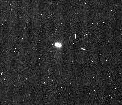 Loge imaged by Cassini spacecraft in October 2011 | |
| Discovery | |
|---|---|
| Discovered by | Scott S. Sheppard David C. Jewitt Jan T. Kleyna Brian G. Marsden |
| Discovery date | 2006 |
| Designations | |
Designation | Saturn XLVI |
| Pronunciation | /ˈlɔɪ.eɪ/ or spelling pronunciation /ˈloʊɡiː/ |
Named after | Logi |
| S/2006 S 5 | |
| Orbital characteristics[1] | |
| 23065000 km | |
| Eccentricity | 0.187 |
| −1312.0 days | |
| Inclination | 167.9° |
| Satellite of | Saturn |
| Group | Norse group |
| Physical characteristics[2][3] | |
| 5+50% −30% km | |
| 6.9±0.1? h | |
| Albedo | 0.06 (assumed) |
Spectral type | r – i = 0.15 ± 0.08[4] |
| 24.6 | |
| 15.3 | |
Loge or Saturn XLVI is a natural satellite of Saturn. Its discovery was announced by Scott S. Sheppard, David C. Jewitt, Jan Kleyna, and Brian G. Marsden on 26 June 2006, from observations taken between January and April 2006.
Loge is about 5 kilometres in diameter, and orbits Saturn at an average distance of 23,142,000 km in 1314.364 days, at an inclination of 166.5° to the ecliptic (165.3° to Saturn's equator), in a retrograde direction and with an eccentricity of 0.1390. It has a tentative rotation period of about 6.9±0.1 hours,[2] but this is highly uncertain as the light curve is the shallowest among all the irregular moons studied by Cassini–Huygens (amplitude about 0.07 magnitudes).[3]
It was named in April 2007, after Logi, a fire giant from Norse mythology.
- ^ S.S. Sheppard (2019), Moons of Saturn, Carnegie Science, on line
- ^ a b Denk, T.; Mottola, S. (2019). Cassini Observations of Saturn's Irregular Moons (PDF). 50th Lunar and Planetary Science Conference. Lunar and Planetary Institute.
- ^ a b Denk, Tilmann; Mottola, Stefano; Tosi, Frederico; Bottke, William F.; Hamilton, Douglas P. (2018). "The Irregular Satellites of Saturn" (PDF). In Schenk, P.M.; Clark, R.N.; Howett, C.J.A.; Verbiscer, A.J.; Waite, J.H. (eds.). Enceladus and the Icy Moons of Saturn. Space Science Series. Vol. 322. Tucson, AZ: The University of Arizona Press. pp. 409–434. Bibcode:2018eims.book..409D. doi:10.2458/azu_uapress_9780816537075-ch020. ISBN 9780816537075.
- ^ Peña, José; Fuentes, Cesar (2022-05-17). "Colors of Irregular Satellites of Saturn with the Dark Energy Camera". The Astronomical Journal. 163 (6): 274. arXiv:2204.08391. Bibcode:2022AJ....163..274P. doi:10.3847/1538-3881/ac6258. ISSN 1538-3881.